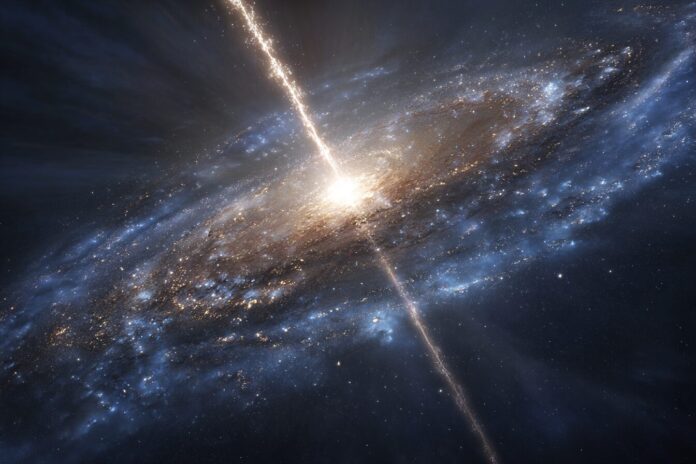On March 16, 2025, astronomers made a landmark discovery: the brightest fast radio burst (FRB) ever recorded. This discovery, originating from approximately 130 million light-years away in the constellation Ursa Major, has captured global attention for its unprecedented detail and sheer intensity. Most importantly, this event, dubbed RBFLOAT (Radio Brightest Flash Of All Time), provides a unique opportunity for researchers to delve deeper into one of astrophysics’ most tantalizing mysteries.
Because of its exceptional brightness and relative proximity, RBFLOAT not only offers insights into the mechanisms behind FRBs but also acts as a natural laboratory for studying cosmic conditions. Furthermore, the detection has set the stage for exciting future discoveries that could reshape our understanding of the universe. Besides that, it emphasizes the importance of advancing our technological methods in radio astronomy, as seen with the work done by instruments like CHIME and NASA’s James Webb Space Telescope (JWST).
What is a Fast Radio Burst?
Fast radio bursts, or FRBs, are extraordinarily brief yet powerful flashes of radio frequency energy. These events, lasting only a few milliseconds, outshine all other radio sources in their host galaxies during their fleeting existence. Because they travel across huge cosmic distances, FRBs illuminate not only the explosive events that produce them but also the largely invisible matter dispersed between galaxies.
Most importantly, FRBs have intrigued scientists since their discovery in 2007; they pose several fundamental questions about their origins. Therefore, researchers continue to debate whether these bursts are driven by magnetars, binary neutron star mergers, or even the dynamic activity around black holes. As detailed by recent findings on MIT News and Bioengineer.org, each theory contributes unique insights into the diverse cosmic phenomena.
The Breakthrough Observation: RBFLOAT
The breakthrough observation that led to the recording of RBFLOAT is remarkable for several reasons. Not only was this event the brightest of its kind, but it also emanated from a relatively nearby galaxy, NGC 4141. This proximity allows astronomers to capture the burst in exceptional detail and opens up vast potential for future research. Because the burst was detected only 130 million light-years away, scientists now have the chance to closely study its origin and impact in a way that was not possible with more distant FRBs.
Moreover, the energy released during RBFLOAT was colossal—comparable to the energy output of our sun over several days, yet concentrated within mere milliseconds. Therefore, this event fundamentally challenges our understanding of the physical limits and diversity of FRBs. As reported by Phys.org, this extraordinary flash prompts a reassessment of what FRBs can tell us about extreme cosmic events.
How Did Astronomers Detect It?
CHIME, the Canadian Hydrogen Intensity Mapping Experiment, originally designed to map hydrogen across the cosmos, has emerged as a frontrunner in detecting FRBs. The recent detection of RBFLOAT was made possible with the help of CHIME’s Outrigger array, a network of telescopes strategically placed across North America. This system allows for precise triangulation, thereby pinpointing the exact position of the burst to an area as small as 45 light-years across.
Because of this coordinated approach, astronomers not only confirmed the host galaxy but also identified the precise region within NGC 4141 where RBFLOAT occurred. Furthermore, NASA’s James Webb Space Telescope (JWST) played a crucial role in this discovery by providing high-resolution imaging that ruled out alternative origins. Most importantly, this collaborative effort exemplifies how modern technology and international teamwork can push the boundaries of astro-scientific research. Insights from Live Science further illustrate how such synergy advances our knowledge of cosmic phenomena.
Why Are Fast Radio Bursts Important?
Understanding FRBs holds the key to exploring some of the universe’s most extreme environments. Their intense radio emissions act as probes, revealing the composition and structure of the intergalactic medium. Because FRBs traverse vast distances, every burst carries valuable clues regarding conditions otherwise hidden from our view.
Most importantly, the study of FRBs is closely linked to unlocking the secrets of exotic astrophysical objects, such as magnetars. Some studies hypothesize that the powerful magnetic fields of magnetars can generate such bursts while others explore scenarios involving binary neutron star mergers or even accretion processes around black holes. As noted in research from ASTRON, each hypothesis broadens our perspective on cosmic evolution and extreme physics. Therefore, the investigation of RBFLOAT is particularly significant because it deepens our understanding of how such high-energy events can be reliably traced back to their sources.
The Road Ahead: Unraveling the Cosmic Mystery
This exceptional discovery marks a turning point in FRB research. With the advent of cutting-edge instruments like CHIME and JWST, scientists stand at the threshold of a new era in radio astronomy. Consequently, future studies will undoubtedly leverage these technologies to observe FRBs with even greater clarity and frequency.
Because of the detailed insights provided by RBFLOAT, researchers now have an enhanced framework to test longstanding theories and develop innovative models of cosmic behavior. Most importantly, these studies promise to refine our understanding of the universe, its underlying structures, and the events that sculpt its evolution. Therefore, every new FRB detection brings us one step closer to comprehending the broader dynamics of our cosmos.
Besides that, public engagement and collaborative international research are likely to accelerate further advancements in this field. By building upon pioneering studies such as this, the astronomical community is poised to unlock mysteries that extend far beyond the confines of our current scientific paradigms.
References & Further Reading
- MIT News: Astronomers detect the brightest fast radio burst of all time
- Bioengineer.org: Astronomers Discover the Brightest Fast Radio Burst Ever Recorded
- Phys.org: Outrigger system traces brightest-ever radio burst to a nearby galaxy
- Live Science: James Webb telescope traces origin of brightest fast radio burst ever detected
- ASTRON: Astronomers pinpoint the source of the brightest one-off fast radio burst ever



